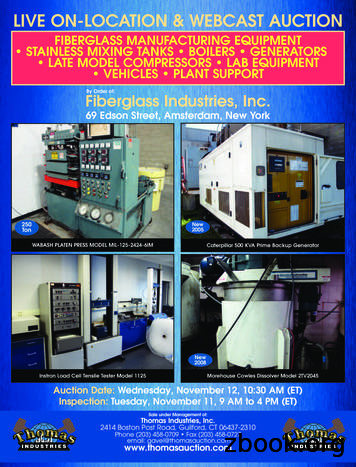ThermoSorb Desiccant Dryers - INGERSOLL RAND
ThermoSorb Desiccant Dryers
Why dry compressed air?Contamination reducesefficiencyThe air we breathe contains contamination in theform of water vapour and airborne particles.During the compression process an aircompressor concentrates these contaminants anddepending on the design and age will even add tothe contamination in the form of oil carry over.Modern air compressors generally have built inaftercoolers that reduce the discharge temperatureof the compressed air and with the help of waterseparators, remove the bulk of liquid water.AIR CONTAMINATIONIn some applications this may be sufficient, but theremaining dirt and moisture content suspended inaerosol form, will, if not removed, damage thecompressed air system and cause product spoilage.INCREASEDSYSTEMDOWNTIMEQuality MattersIngersoll-Rand desiccant air dryers will provideclean compressed air to the highest waterclassification as prescribed by ISO 8573.1.ISO 8573.1 Quality ClassesQUALITYCLASSDIRTParticle sizein MicronWATEROILPressure Dewpoint C(Including(ppm. vol.) at 7 bar g vapour) mg/m310.1-70 (0.3)0.0121-40 (16)0.135-20 (128)1.0415 3 (940)5540 7 (1240)256- 10 (1500)-Installation GuideREDUCEDPRODUCTIONEFFICIENCYSierraThe result - higher overall cost of operation from: Increased system downtime Reduced production efficiencyThese problems can be avoided with the correctselection and application of compressed air filtersand dryers from Ingersoll-Rand.The Air Solutions Group at Ingersoll-Rand has thewidest selection of products and applicationknowledge to protect your investment and yourcompressed air system. Filters Refrigeration dryers Condensatemanagement Desiccant dryers Cooling systems2 Piping systemsISO 8573.1 Class 2.2.1 Dirt, Water and OilAir quality - With correct selection, the aboveschematic relates to an installation that wouldprovide Class 2 dirt, Class 2 water, and Class 1oil. This is recommended to stop downstreamcorrosion, prevent product spoilage andprolong the life of pneumatic tools and thecompressed air system.
TZV Technical SpecificationsNominal Flow*TypeDimensions in mmm 21152240229024802530DN 40DN 40DN 50DN 50DN 80DN 80DN 80DN 100DN 100DN 100DN 150DN 150DN 150DN 150DN 150DN 200DN 200DN 200DN 250DN 2503TZV 070TZV 085TZV 107TZV 142TZV 197TZV 250TZV 330TZV 392TZV 488TZV 592TZV 683TZV 790TZV 875TZV 1035TZV 1183TZV 1333TZV 1533TZV 1800TZV 2050TZV 2417DewpointWeightkgInstalledPower kWAbsorbedPower .342.049.452.962.771.281.497.3111.2-40 C NominalWorking PressureMinimumMaximum4 bar g (58 psi g)10 bar g (232 psi g)Inlet TemperatureMinimumMaximum2 C (36 F)40 C (104 F)**Ambient TemperatureMinimumMaximum2 C (36 F)35 C (86 F)Standard Voltage400/3/50IP RatingIP54* Referenced to 20 C (68 F) and 1 bar a (14.5 psi a)All dryers conform to ISO 8573.1**Higher temperatures on requestCorrection factors for sizing dryers depending on inlet temperature and pressure (-40 C)bar gTemp esign example:Flow:Pressure:Max. inlet temp.:PDP:Correction Factor:50 m3/min5.0 bar g30 C-40 0.80a) Calculation of the specific dryer capacityb) Calculation of the max. flow in m3/minFlow x Correction Factor68.3 x 0.80 54.7 m3/minc) Reserve available equals maximum flow - actual flow54.7 m3/min - 50 m3/min 4.7 m3/minFlow50 m3/min 62.5 m3/min Correction Factor0.80Selected: Type TZV 6837
TZV Features and BenefitsThe Ingersoll-Rand TZV externally heated(electrical or steam) vacuum dryer with zerocompressed air loss makes this dryer, themost cost effective and economical dryer onthe market. Vacuum Regeneration- Reduces the energy costs required inheat for regeneration.- Reduces the energy required in for thecooling cycle.- Reduces temperature stress on desiccantoptimizing life No System Compressed Air LossVacuum pump- Zero loss of dry compressed airsaves energy- Maximum process air available Constant Dew Point- No temperature spikes at changeover- Rated at -40 C as standard- Two layers of desiccant for optimumefficiencyLow maintenance valving Total Reliability- Easy to maintain- Galvanised inlet and outlet piping- Low maintenance valving Stainless Steel Desiccant Support- Maximum flow distribution- Low pressure drop Electronic Controller- LCD display of running conditions andalarms- Energy Management System available asan optionTZV schematic (recommended installation)6
Desiccant dryersWhy Desiccant?Energy Management SystemRefrigeration dryers are excellent for providing lowercost ‘dry’ compressed air. But they cannot achievepressure dew points down below 0 C because thewater vapour in the compressed air would freeze,blocking pipes and damaging downstreamequipment.Regeneration air requirement is dependent on flow,pressure and temperature. Compressed air systemsare rarely constant. All three factors changeaccording to the compressor loading, the ambienttemperature and relative humidity. This means that aconstant regeneration flow usually wastescompressed air.To provide pressure dew points down to -40 C orlower, a desiccant dryer is the most effectivesolution. The Ingersoll-Rand ThermoSorb dryer usestwin columns filled with desiccant beads to dry thecompressed air.Tiny pores within the desiccant beads trap moistureand remove it permanently from the compressed airsupply. The temperature of the compressed air is notlowered, so there is no danger of water vapourfreezing.The EMS measures the outlet air dew point andadjusts the cycle time accordingly. This can loweroperating costs dramatically by reducing theregeneration air usage.The EMS is integrated into the dryer controller, andshows the outlet dew point. The alarm function canbe signaled remotely using a volt free contact.Stainless steel wedge wire distribution plate.The desiccant is supported by a self cleaningstainless steel wedge shaped support screen. Thisensures lower differential pressures, constantpressure dew points and increases desiccant life.To maintain acceptable pressure dew point levels,the desiccant must be regenerated by removing thewater vapour collected within the desiccant. Themost common methods used are either heatless(TZ) or heated vacuum technology (TZV).TZV controller3
TZ Features and BenefitsElectronic control and compact designcombine to give high performance withminimum space requirements Compact Non Return Valves- Long life- Reduced maintenance. Electronic Controller- Reliable and simple- Energy Management System (EMS)available as an option Ease of Installation- Complete with pre and after filter(up to TZ 142) Efficient Operation- Dryer control can be matched to load/unloadstate of compressor Stainless Steel Desiccant Support- Maximum flow distribution- Low pressure drop Electronic Pneumatic Valve Control- Simple trouble free operation. Power Failure Protection- Back up ensures continuity on powerrestoration. Simple Inlet Valve Block- Fewer and simpler connections- Ease of maintenance- Minimum pressure drop4DP Grade FilterHE Grade FilterTZ 022-142 schematic (recommended installation)
TZ Technical SpecificationsNominal Flow*TypeDimensions in mmm /mincfmABCAirWeightConnectionTZ 0222.2775654401700G1127TZ 0282.81015954401700G1162TZ 0383.81366344601760G1206TZ 0505.01776344601800G12373kgTZ 0616.12168205401860GTZ 0878.73088745401860G 11/238211/2350292TZ 11711.74149055101975TZ 14214.250310155101995G2436TZ 19219.268010608402070DN 50640TZ 25025.088812709002110DN 65830TZ 32532.5115413509902150DN 65955TZ 39239.21390153010402210DN 801075TZ 50050.01775160011002230DN 801500TZ 63363.32248187512002340DN 1001990TZ 76776.72722191012502640DN 1002410TZ 93393.33314216011502815DN 1252850DewpointG11/2-40 C NominalWorking PressureTZ 022-142TZ 192-933MinimumMaximumMaximum4 bar g (58 psi g)16 bar g (232 psi g)10 bar g (192 psi g)Inlet TemperatureMinimumMaximum2 C (36 F)50 C (122 F)Ambient TemperatureMinimumMaximum2 C (36 F)50 C (122 F)Standard VoltageA230/1/50IP RatingIP54TZ 022 - TZ 142* Referenced to 20 C (68 F) and 1 bar a (14.5 psi a)Inlet 35 C. 7 bar gAll dryers conform to ISO 8573.1Temp 780.730.6771.000.910.820.79bar .07121.621.471.351.29CCorrection factors for sizing dryers depending on inlet temperature and pressure(Pressure dewpoint -40 C)141.791.671.571.46162.141.831.741.68ABTZ 192 - TZ 933higher inlet temperatures on requestDesign example:Flow:Pressure:Inlet temperature:PDP:6.3 m3/min8.0 bar g35 C-40 Ca) Calculation of the specific dryer flowb) Calculation of the max. dryer flow in m3/minCapacity: Flow x Correction Factor6.1 m3/min x 1.08 6.6 m3/minc) Reserve available equals maximum flow - actual flow6.6 m3/min - 6.3 m3/min 0.3 m3/minFlow6.3 m3/min 5.8 m3/min Correction Factor1.08Selected: Type TZ 0615
More Than Air. Solutions.Online solutions: http://www.air.irco.comIngersoll-Rand air compressors are not designed, intended, or approved for breathing air. Compressed air should not be used for breathing airapplications unless treated in accordance with all applicable codes and regulations.Nothing contained in this brochure is intended to extend any warranty or representation, expressed or implied, regarding the products describedherein. Any such warranties or other terms and conditions of sale shall be in accordance with Ingersoll-Rand’s standard terms and conditions ofsale for such products, which are available upon request.Product improvement is a continuing goal at Ingersoll-Rand. Designs and specifications are subject to change without notice or obligation.Air Solutions22135834Printed in UK 2001 by Ingersoll-RandESA Business CentreIngersoll-Rand European Sales LimitedSwan Lane,Hindley GreenWigan WN2 4EZ, United KingdomTel: 44 (0) 1942 257171Fax: 44 (0) 1942 254162www.air.irco.com
lower, a desiccant dryer is the most effective solution. The Ingersoll-Rand ThermoSorb dryer uses twin columns filled with desiccant beads to dry the compressed air. Tiny pores within the desiccant beads trap moisture and remove it permanently from the compressed air supply. The temperature of File Size: 1MB
HL Heatless Desiccant Dryers Ingersoll Rand heatless desiccant dryers thoroughly capture moisture in the compressed air produced as it is directed through the online desiccant-filled dryer tower of the dryer. As the desiccant in this tower adsorbs water from the air, the desiccant in the dryer
HYPERTHERM Powermax 600 Plasma Cutter AIR COMPRESSORS 2013 INGERSOLL-RAND 150-HP Air Compressor, Model R110NC-A, S/N VNN1239U13282, V/S Drive (2) INGERSOLL-RAND 200-HP Air Compressors, Model SSR-EPE200-25 INGERSOLL-RAND 100-HP Air Com-pressor, Model IRN100JCC INGERSOLL-RAND Air Compressor, Model IRN15H-CC-115-H (2) INGERSOLL-RAND Air Dryers,
from the air, the desiccant in the dryer’s Selecting An Ingersoll Rand Desiccant Dryer off-line tower is purged of moisture and readied for use. The basic difference in the three technologies is the manner in which moisture is desorbed from the desiccant, also known as regeneration. Heatles
Ingersoll Rand Desiccant Dryer Controls All Ingersoll Rand desiccant dryers, models HL, EH and HB, are supplied with a digital electronic multi-function controller as standard equipment. This is the dryer’s comman
Dryer d Dryer Refriger yer 40K Heat yer 30K 1 K K 0 Clean, Dry Oil-Free Air Ingersoll Rand heat of compression (HOC) dryers provide energy efficiency, flexibility and reliability. Energy Efficiency Ingersoll Rand HOC dryers provide instru
AIR COMPRESSORS - DRYERS Ingersoll Rand 200 HP Rotary Screw Air Compressor Model IRN200H-2S, S/N NFF0563U08256, (New 2008) 145 PSIG w/ Ingersoll Rand Heatless Dessicant Dryer #HL2001HE0AA, (2) Receiver Tanks Ingersoll Rand 100 HP Rotary Screw Air Compressor Model IRN100H-CC, S/N NV8962U10344 (New 2010) Ingersoll Rand 40 HP Rotary Screw Air
The Ingersoll Rand Blower Purge Desiccant Dryers are designed to adsorb moisture from compressed air. The dryers are constructed with two towers, each containing desiccant beads, that alternate between on- lin
manufacturers in the automotive industry. The ‘Xtra’ range of products are also more resistant to humidity and thermal cycling (rapid changes in heating and cooling) than the standard range. The following graph shows the effects of humidity (168 hours, 25 C, 90% RH) and thermal cycling (25 cycles between -25 C and 65 C) on HTC and HTCX. The results show that the rheology of HTC changes .























